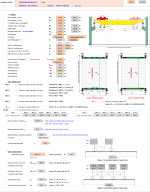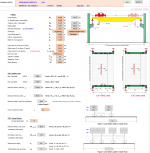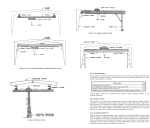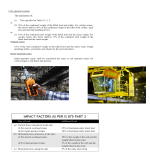Wheel Load computation for crane girders

Description
The spreadsheet claculated wheel load on crane girder easy input options are provided for inputs. User friendly and much easier to use.
Crane girders are structural members that support the rails for overhead traveling cranes. The wheel loads from the crane need to be accurately computed to design and analyze the crane girders. Here's a step-by-step process for computing wheel loads for crane girders:
-
Identify crane parameters: Gather information on the crane's maximum capacity, trolley weight, bridge weight, number of wheels, wheel spacing, and the distance between the crane girders.
-
Calculate total crane load: Compute the total crane load, which includes the maximum lifting capacity, trolley weight, and bridge weight. For example:
Total_crane_load = Max_capacity + Trolley_weight + Bridge_weight
-
Determine load distribution: Distribute the total crane load among the wheels. Divide the total crane load by the number of wheels to get the load on each wheel.
Load_per_wheel = Total_crane_load / Number_of_wheels
-
Calculate wheel loads on girders: Since the crane load is transferred to the crane girders through the wheels, we need to calculate the loads acting on each girder. Distribute the load per wheel between the two girders, considering the distance between them.
Load_per_girder = Load_per_wheel * (Distance_between_wheels / Distance_between_girders)
-
Compute impact factor: Cranes are subject to dynamic effects, such as impact, during operation. An impact factor should be considered to account for these effects. Impact factors vary depending on the crane's speed, operation, and applicable codes or standards. Multiply the wheel loads on each girder by the impact factor to obtain the total wheel loads on the girders.
Total_wheel_load = Load_per_girder * Impact_factor
-
Analyze load combinations: Consider various load combinations that include the wheel loads, dead loads, and other live loads that may act on the crane girders. Follow the applicable design codes or standards to determine the appropriate load combinations and factors.
-
Design and analyze the crane girders: Use the computed wheel loads and other loads acting on the crane girders to design and analyze the girders for strength, stiffness, and stability. This may involve selecting the appropriate girder size, material, and connection details, as well as verifying the girder's performance under the applied loads using analytical methods or numerical simulations (e.g., finite element analysis).
In summary, computing wheel loads for crane girders involves identifying crane parameters, calculating the total crane load, determining load distribution, calculating wheel loads on girders, computing the impact factor, analyzing load combinations, and designing and analyzing the crane girders. Accurate computation of wheel loads is crucial for ensuring the safe and effective design of crane girders in overhead traveling crane systems.
There are several international and regional codes of practice for the design of overhead cranes. These codes provide guidelines and standards for the design, fabrication, installation, inspection, testing, and maintenance of overhead traveling cranes. Some of the most commonly used codes of practice include:
-
CMAA (Crane Manufacturers Association of America): CMAA Specification No. 70 - 'Specifications for Top Running Bridge and Gantry Type Multiple Girder Electric Overhead Traveling Cranes' and CMAA Specification No. 74 - 'Specifications for Top Running & Under Running Single Girder Electric Traveling Cranes Utilizing Under Running Trolley Hoist'.
-
ISO (International Organization for Standardization): ISO 4301-1:2016 - 'Cranes -- Classification -- Part 1: General' and ISO 4306 series - 'Cranes -- Vocabulary'.
-
FEM (Fédération Européenne de la Manutention): FEM 1.001 - 'Rules for the Design of Hoisting Appliances' provides a comprehensive set of guidelines for the design of various types of cranes, including overhead traveling cranes.
-
DIN (Deutsches Institut für Normung): DIN 15018 - 'Cranes; steel structures; principles of design and construction' is a German standard that covers the design and construction of crane steel structures, including overhead cranes.
-
BS (British Standards Institution): BS 466-1:1984 - 'Specification for power driven overhead travelling cranes, semi-goliath and goliath cranes for general use' is a British standard that covers the design, construction, and testing of overhead cranes.
-
ASME (American Society of Mechanical Engineers): ASME B30.2 - 'Overhead and Gantry Cranes (Top Running Bridge, Single or Multiple Girder, Top Running Trolley Hoist)' is a widely recognized American standard for overhead cranes.
-
CSA (Canadian Standards Association): CSA B167-16 - 'Safety Standard for Maintenance and Inspection of Overhead Cranes, Gantry Cranes, Monorails, Hoists, and Trolleys' is a Canadian standard that covers the design, inspection, and maintenance of overhead cranes.
-
AS (Australian Standards): AS 1418.1-2002 - 'Cranes, hoists and winches - Part 1: General requirements' is an Australian standard that provides guidelines for the design, construction, and testing of cranes, including overhead traveling cranes.
It is essential to follow the relevant codes of practice and standards applicable to the specific country or region where the overhead crane is being designed, fabricated, and installed. The codes of practice ensure that the crane design meets the required safety, performance, and quality standards to ensure safe and efficient operation.
Calculation Preview
Full download access to any calculation is available to users with a paid or awarded subscription (XLC Pro).
Subscriptions are free to contributors to the site, alternatively they can be purchased.
Click here for information on subscriptions.






